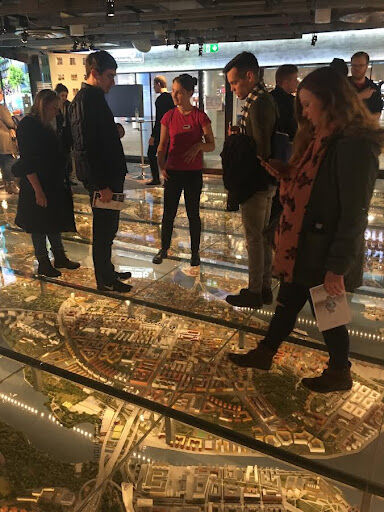Iowa State partners with the U.S. State Department

Image courtesy of Ted Grevstad-Nordbrock
Iowa State students stand on a raised glass floor above a model of Stockholm, Sweden at the Kulturhuset, or “The House of Culture,” during the 2018 trip to Stockholm.
March 8, 2022
Iowa State has a one-on-a-kind partnership with the U.S. State Department Office of Cultural Heritage.
The partnership was started in 2016 and is formally called the ISU-U.S. Department of State Cultural Heritage Documentation Project, although the partnership is informal in nature, according to Ted Grevstad-Nordbrock, an assistant professor of community and regional planning who helped found the program.
The goal of the project is to interpret historic buildings owned by the U.S. State Department all over the world. The department owns over 200 historic properties.
“This partnership with the state department allows us to create a design-oriented project at one of [the] U.S. government facilities abroad,” said Grevstad-Nordbroack. “It allows us to take students abroad and we can learn about different cities and different cultures and learn about heritage and historic preservation at the same time.”
Students from Iowa State partake in the program by enrolling in a class that takes a trip to one of these sites as part of the course. The class may be a design class or part of the community and regional planning department.
Since 2016, Iowa State has taken students to London in 2017, Dublin, Ireland in 2017, Prague, the Czech Republic in 2018, Tangier, Morocco in 2019, Edinburgh, Scotland in 2019, and Lisbon, Portugal in 2020.
“I chose to participate … because it was part of the first course I was taking in historic preservation and seemed like a good way to get more fully introduced to the field,” said Michael Belding, a graduate student in history who went on the trip to London. “The big course project was to design a commemoration of the American presence on Grosvenor Square in London, where the former Chancery building is and we presented those to some Department of State employees one day… [This] really expanded my sense of what preservation includes.”
Belding believes that the partnership is important for four reasons:
-
It gives students more opportunities to study abroad.
-
It deals with historic properties that have significance to the U.S. and the country they’re located in.
-
It is important for the U.S to take care of its properties outside of the country while occupying them.
-
It gives an occasion to study historic preservation in places with different environments, histories and contexts.
Sarah Bartlett, a graduate student in anthropology who traveled to Edinburgh in 2018, also believes that the program is important for students.
“It gives students an opportunity to go places and meet people they would otherwise not have a chance to,” Bartlett said. “These inside glimpses set them apart in the job field and help them to be more well-rounded as scholars in general.”
As part of the Edinburgh trip, Bartlett and her group worked with the Patrick Geddes Foundation, which works on preservation in the city, and got a first-hand look at the tension that can arise when doing preservation work.
“There were two camps, those who think that they should save every building and find some sort of adaptive reuse for it and those who think that the city is stuck in the past and should work to modernize,” said Bartlett. “To say there is tension between these two groups is an understatement. I got the sense that we were really getting a glimpse into what the processes and debates in preservation were like.”
Those on the Edinburgh trip also toured the U.S. Consulate, where they met the acting consulate general at the time.
Another trip is scheduled for May to Rome as part of the program. A class of about 10 students will travel to the Rome U.S. Embassy campus and work with state department employees to study the historic buildings.















